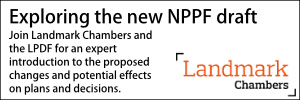A lesson in legal alchemy
- Details
A CAAD appeal relating to 135 homes was recently dismissed as inappropriate development in the Green Belt. James Pereira QC and Daisy Noble explain why.
In Leech Homes v Northumberland County Council [2020] UKUT 150 (LC) the Deputy President of the Upper Tribunal (Lands Chamber), Martin Rodger QC and Diane Martin MRICS FAAV handed down judgment in a CAAD appeal by Leech Homes. The Tribunal rejected Leech Homes’ argument that a residential scheme of approximately 135 dwellings was appropriate alternative development (AAD) for land acquired by the Council for the purposes of constructing the Morpeth Northern Bypass. The bypass had been authorised by a Development Consent Order made under the Planning Act 2008.
The principal issue concerned whether or not the appeal site would have been treated as Green Belt at the valuation date. This turned on the interpretation of a strategic level policy contained in a Regional Spatial Strategy that provided for a Green Belt extension, the general extent of which was shown on an indicative diagram that included within its scope the appeal site. The policy expressly left the precise boundaries to be defined by Local Plans. No Local Plan had been adopted for Morpeth at the valuation date, and so no detailed boundaries had been drawn.
What was interesting about this case is that the council had made representations to the DCO examining Inspector that the site did not lie within the Green Belt, and there was also evidence of planning decisions taken by the council around the valuation date that had treated nearby sites as falling outside the Green Belt. The Appellant relied upon this as evidence that the site should be treated as outside the Green Belt for the purposes of the CAAD process. However, the Tribunal confirmed the established approach that the issue was not whether the actual local planning authority would have treated the land as Green Belt or not, but whether a reasonable planning authority would have done so. The significance of previous decisions therefore depended upon whether or not they reflected the correct interpretation of policy. Applying this approach, it upheld the council’s argument that a reasonable planning authority directing itself properly on the law and on the effect of strategic policy would have treated the site as Green Belt at the valuation date.
The Tribunal did not consider that very special circumstances had been identified that would outweigh the harm resulting from the development which was by definition, inappropriate development in the Green Belt.
As for the position after the valuation date, the Tribunal concluded that cancellation of the bypass would have caused a re-assessment of the strategy underlying the development plan that was emerging at the valuation date. This and other factors meant that the likelihood of planning permission for the contended AAD at a time after the valuation date was not proven.
By way of a post-script, the Tribunal’s decision also reinforced the caution needed when expert evidence is provided by an employee of a party. In this case the Appellant’s planning expert was an employee of Leech Homes’ parent company. Whilst the Tribunal admitted the evidence (an outcome supported by both parties), it observed that “any employee of a commercial business would find it difficult to form objective and independent opinions”. The decision serves as a reminder of the Tribunal’s approach to the independence and objectivity of expert witnesses.
James Pereira QC and Daisy Noble are barristers at Francis Taylor Building. They appeared for the successful respondent, Northumberland County Council.
Sponsored articles
Walker Morris supports Tower Hamlets Council in first known Remediation Contribution Order application issued by local authority
Unlocking legal talent
Principal Lawyer - Planning, Property & Contract
Legal Director - Government and Public Sector
Contracts Lawyer
Lawyer (Planning and Regulatory)
Senior Lawyer - Planning, Property & Contracts Team
Locums
Poll








































